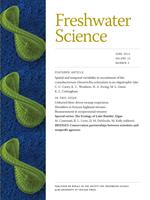Lake benthic cyanobacteria and algae are distributed along a depth gradient. At the extremes of the gradient, irradiance is a selecting factor because of excess (UV exposure in shallow waters) or extreme reduction (light limitation at the bottom of the euphotic zone). We tested whether, how, and to what extent epilithic cyanobacteria assemblages change with depth in a carbonate meromictic lake (Lake Tovel, southeastern Alps) that undergoes marked water-level fluctuations. Fixed stations were placed along a transect at 2- to 3-m depth intervals from 0 to 24 m and were sampled by SCUBA divers. Three depth-distribution zones were identified based on the composition of cyanobacterial assemblages and primary benthic algal pigments: shallow, middepth, and deep. The autecological traits of the cyanobacteria indicators identified by indicator value (IndVal) analysis suggested that the shallow, mid-depth, and deep zones were disturbed by water-level fluctuations, highly stable with favorable growth conditions, and severely light-limited, respectively. The shallow zone was colonized mainly by pseudaerial cyanobacteria and by UV-resisting phenoecodemes with yellow—brown sheaths (scytonemin). Shannon—Wiener diversity was highest in the shallow zone, probably because taxa characteristic of periodically inundated habitats mixed with lacustrine taxa. The most unique morphospecies were in the lower part of the mid-depth and in the deep zone. These species frequently had colorless sheaths or pink—red—violet cell contents. We found clear patterns in the depth distribution of benthic cyanobacteria and algal pigments that indicated adaptation to the principal evolutionary pressures at the extremes of the depth gradient: water-level fluctuation and light attenuation. These features have implications for quality assessments, biodiversity inventories, and identification of areas affected by water-level fluctuations.
How to translate text using browser tools
1 June 2014
Depth distribution of epilithic cyanobacteria and pigments in a mountain lake characterized by marked water-level fluctuations
Marco Cantonati,
Graziano Guella,
Jiří Komárek,
Daniel Spitale
ACCESS THE FULL ARTICLE
It is not available for individual sale.
This article is only available to subscribers.
It is not available for individual sale.
It is not available for individual sale.

Freshwater Science
Vol. 33 • No. 2
June 2014
Vol. 33 • No. 2
June 2014
carbonate mountain lakes
cyanobacteria
depth distribution
epilithon
light
PAR
periphyton




